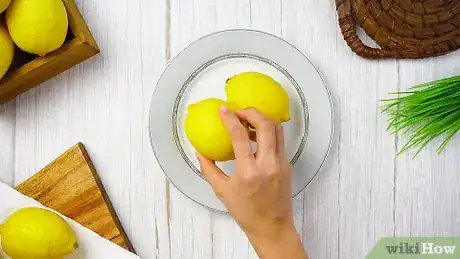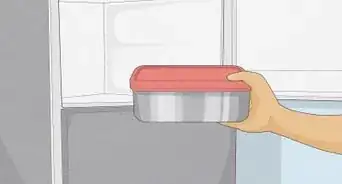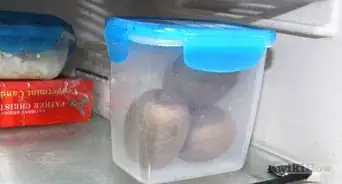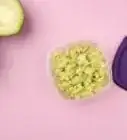wikiHow is a “wiki,” similar to Wikipedia, which means that many of our articles are co-written by multiple authors. To create this article, 12 people, some anonymous, worked to edit and improve it over time.
There are 8 references cited in this article, which can be found at the bottom of the page.
The wikiHow Video Team also followed the article's instructions and verified that they work.
This article has been viewed 278,214 times.
Learn more...
Lemons are often coated with wax to keep the peel fresh and glossy. This wax is considered safe to eat, but if you need to zest the lemon, you may still wish to de-wax it before proceeding.[1]
Steps
Using Boiling Water
-
1Boil water. Fill a kettle halfway with water and bring the water to a boil on the stove.[2]
- You could use a small saucepan instead of a kettle. Fill the saucepan halfway with water and boil it on the stove over high heat.
- If necessary, you could use hot tap water instead of boiled water. Make sure that the tap water is as hot as possible before pouring it over the lemons.
-
2Place the lemons in a colander. As the water is heating up, arrange the lemons in a colander, keeping them in a single layer. Place the colander in your kitchen sink.[3]
- It's best to work with only a few lemons at a time so that they can move around freely in the bottom of the colander. If you pile the lemons together, less of the peel will be visible, making it more difficult for the hot water to come into contact with the wax.
Advertisement -
3Pour the boiling water over the lemons. Once the water in your kettle reaches a boil, pour it over the lemons in your colander.[4]
- The heat of the water will partially melt the wax, loosening it from the peel and making it easier to strip away.
-
4Scrub the fruit with a vegetable brush. Use a vegetable brush to gently scrub the outer peel of each lemon. Hold the lemon under cool, running water as you scrub.[5]
- Scrub the lemons one at a time.
- It is important to use cold water. The boiling water heated the lemon peel, and the cold water quickly drops it back down to a more suitable temperature.
- Avoid using a brush or scrubbing sponge used for dishes. Soap residue inside the brush could get onto the fruit and contaminate the peel.
-
5Rinse well. Give each lemon a final rinse to remove any additional wax residue.
- Lightly scrub the peel with your fingers during this step.
-
6Dry thoroughly. Gently wipe the outside of each lemon with a clean paper towel to dry the peel.
- You could also allow the lemons to air dry on your kitchen counter instead of using paper towels.
- Only store dewaxed lemons after they have been thoroughly dry.
Microwaving to Remove Wax
-
1Place the lemons on a microwave-safe plate. Arrange the lemons on a microwavable plate or in a microwavable dish. Keep them in an even, single layer.
- Work with only a few lemons at a time for best results.
- Do not stack the lemons on the plate. Stacking them can result in uneven heating, which may make it difficult to fully strip away the wax.
-
2Microwave for 10 to 20 seconds.[6] [7] Place the plate of fruit in the microwave. Run the microwave on high for 10 to 20 seconds, depending on how many lemons you are working with.
- If you are only working with one or two lemons, only microwave them for 10 seconds. If you are working with three to six lemons, increase the amount of time to 20 seconds.
- The heat helps melt the wax. The softened wax will be easier to remove from the peel.
-
3Scrub the fruit under running water. Using a vegetable brush, lightly scrub the peel of each lemon while holding it under cool, running water.
- It's best to scrub the lemons one at a time.
- Cool to cold water is ideal since it can cool down the lemon peels after they were heated in the microwave.
- Do not use a vegetable brush previously used with soapy water.
-
4Rinse the lemons. Stop scrubbing and rinse each lemon one last time under the running water.
- You can use your fingers to lightly scrub the peel during this step, but do not use the vegetable brush.
-
5Dry using paper towels. After washing each lemon, pat it dry with clean paper towels.
- The lemons can also be air dried on the kitchen counter, but do not store them while they remain wet.
Making a Fruit and Vegetable Wash
-
1Combine vinegar and water. Pour three parts water and one part white distilled vinegar in a spray bottle. Close the bottle, then shake well to combine.[8]
- A commercial fruit and vegetable wash could be used instead of a homemade one.
- Another possible fruit and vegetable wash can be made by mixing 1 Tbsp (15 ml) fresh lemon juice, 1 Tbsp (15 ml), and 1 cup (250 ml) lukewarm water. Mix these ingredients together in a spray bottle.[9]
-
2Spray the solution onto the lemons. Thoroughly douse all sides of the peel of each lemon with the vinegar cleaning solution.
- Allow the solution to sit on the lemons for two to five minutes before continuing. The acidity of the cleansing solution needs several minutes to weaken and dissolve the wax.
-
3Scrub the lemons under running water. Scrub the lemon peels with a vegetable brush under cool, running water, applying gentle yet firm pressure.
- The temperature of the water is not as significant for this method since no heat was used previously, but lukewarm to cool water is still recommended since it is the least likely to alter the internal temperature of the lemon.
- Avoid using brushes or sponges that were previously used in soapy water.
- Each lemon only needs to be scrubbed briefly.
-
4Rinse under cool water. After you finish scrubbing the lemons, rinse each one under the running water to remove any remaining wax residue.
- If you see any wax debris, you can use your fingers to lightly brush it off while rinsing the fruit. Do not use the brush during this step, however.
-
5Dry well. Quickly dry the lemons by wiping off any water using clean paper towels.
- If desired, you can let the lemons air dry instead of drying them with paper towel.
- Do not store dewaxed lemons that are still wet.
Warnings
- For best results, use the lemons immediately after de-waxing them. Without their protective wax, lemons can spoil faster.⧼thumbs_response⧽
- Do not store dewaxed lemons that are still wet. Make sure that the peels are completely dry to prevent possible issues with premature spoilage.⧼thumbs_response⧽
Things You'll Need
Using Boiling Water
- Kettle
- Stove
- Colander
- Vegetable brush
- Sink
- Paper towels
Microwaving to Remove Wax
- Microwave-safe plate
- Microwave
- Vegetable brush
- Sink
- Paper towels
Making a Fruit and Vegetable Wash
- Spray bottle
- Water
- Vinegar
- Vegetable brush
- Sink
- Paper towels
References
- ↑ https://u.osu.edu/chowline/2014/02/17/wax-off-wax-on-waxed-produce-ok/
- ↑ https://drinks.seriouseats.com/2011/08/cocktail-101-selecting-and-caring-for-citrus-when-to-wash-limes-lemons.html
- ↑ https://www.nigella.com/ask/waxed-lemons-and-other-citrus-fruits
- ↑ http://www.nigella.com/kitchen-queries/view/Waxed-Lemons-and-other-Citrus-Fruits/2329
- ↑ https://www.nigella.com/ask/waxed-lemons-and-other-citrus-fruits
- ↑ https://www.bobvila.com/slideshow/14-things-you-didn-t-know-your-microwave-can-do-49099#how-to-remove-candle-wax
- ↑ http://drinks.seriouseats.com/2011/08/cocktail-101-selecting-and-caring-for-citrus-when-to-wash-limes-lemons.html
- ↑ http://www.barefeetinthekitchen.com/2013/04/diy-fruit-and-vegetable-wash-homemade-produce-wash-recipe.html
- ↑ http://fabulesslyfrugal.com/diy-homemade-vegetable-wash-preserver/
About This Article
Lemons are often coated in a special wax to keep the peel glossy and you may want to remove this if you plan to zest the lemon. One of the easiest ways to do this is by using vinegar to make a fruit and vegetable wash. Combine one part white vinegar with three parts water in a spray bottle. Then, spray the solution over the lemon peels and allow it to sit for 2 - 5 minutes. Next, scrub the lemons with a scrubbing brush under cool, running water to remove the vinegar solution and the wax. For more ways to dewax lemons, like using the boiling water method or the microwave method, read on.


























































